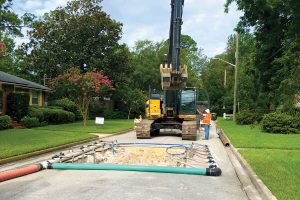Residents raise alarm over sediment spill in Millers Creek
Posted on August 1, 2018 By Editor Articles, Neighborhood News, Top Stories


The water in Millers Creek turned a brownish-yellow color July 24 after JEA inadvertently unleased sediment into the creek.
As far as several Millers Creek residents are concerned, the Jacksonville Electric Authority (JEA) is at it again.
In the early afternoon July 24, Louis Joseph, a creek-side resident raised the alarm to his fellow neighbors after spotting a brownish-yellow sediment flowing into the creek from a drainpipe from property owned by his neighbor Kate Thilges.
The possibility of another “illegal” sediment spill heading into Millers Creek was very concerning for Joseph, who immediately took a video of the floating discharge and called his neighbor, Sharon Johnson. Both Joseph and Johnson are board members of the Millers Creek Special Tax District, a band of 28 creek-side homeowners who have elected to pay $3,000 per year in extra taxes to cover the costs of dredging the silt-filled waterway near their homes.
“Louis noticed it because he was the one who spotted it last time and knew immediately what it was,” said Johnson, president of the special tax district. This incident was the third time JEA had unwittingly released sediment into the creek, she said.
Two years ago, on July 13, 2016, Joseph had also filmed yellow liquid with sediment emitting from the same drain pipe, and in a second video, Jonathan Wright, treasurer of the special tax district, filmed a JEA truck in the background and the chemicals beginning to disperse throughout the creek later that same day.
The July 2016 incident had come on the heels of a similar issue two months before on May 15, 2016, when Bobby Baker of Millers Creek took photos during an incident involving a different storm drain accessing the creek.
After immediately hearing about the July 24 spill, Johnson said she made two calls – one to John Flowe, water branch manager of the city’s Environmental Quality Division (EQD), and to District 5 Councilwoman Lori Boyer’s office. Flowe said he would send a “team” to the site right away, while Boyer’s assistant, Nicole Spradley, acting on Boyer’s behalf, also called Flowe’s office with the same request.
“They were flushing out the piping at a manhole at the corner of Tiber Avenue and Olive Street and there was a big mound of sand nearby. What they are supposed to do, and they don’t, is to erect a barrier so the sediment does not go into the creek, only clear water goes into the creek,” Johnson said. “Like the last time, JEA did not put a protective barrier up so all the sediment – the sand and stuff – was going through the pipe and into the creek. It was a whiteish, yellow sand.”
In a phone interview, Greg Corcoran, a project manager at JEA, said the utility had been called by a resident to attend to two sewer line breaks along Olive Street 30 feet apart near the intersections of Linden Street and Tiber Avenue, a situation he termed “normal standard repair.”
“Any time we have an issue with the road we need to dig down and see what the problem is,” he said, noting in this case the sewer lines were more than seven feet below the road’s surface. Because the water table is so high near the creek JEA had to dewater the hole by putting in a “well-point system” so it could isolate the break, dry out the area, and fix the issue, he said.
“While installing the well-point system, the jet water was routed through a pipe and down to a nearby storm drain,” said Gerri Boyce, spokesperson for JEA in an email. “Filter fabric and gutter barriers were installed in the drains, however with this water and the extremely heavy rains that also happened Tuesday, this did not completely protect the drains. As soon as JEA was aware of the turbid water releasing from the storm drain out to Miller Creek we ceased operations. However, with the continuing rains, waters from the entire storm-water system, some from this job and including anything that was already in the drains, washed into the creek,” she continued. “We have stationed a vac truck to receive the well-point water before it enters the drains and will release this water into our sewer system once the truck is full, instead of having these waters go into the storm-water system.”
Cloudy water in the creek does not necessarily mean new sediment is headed into the creek from the storm-water drains, said Lindsay Starner, a member of JEA’s environmental team. “What happens when water comes out faster than normal into the creek, like you had with our job and the torrential downpours, is called turbidity,” Starner said. “The water mixes everything up that is in the bottom of the creek, so if there is sediment or if you hit the bottom of the creek with water faster than normal it looks like there is being sediment carried down into the water, but that is not necessarily the case.”
Starner said JEA has taken special precautions to ensure that no additional sediment will go into the creek. “We have put a different kind of filter fabric in the work area all along Olive Street down towards Gay, and we have put some sandbags along the filter fabric to ensure that if any sediment were to be washed away due to rain it would not get into the storm drains around that area,” she said, noting the precautions are being checked three times a day.
JEA also put up a “turbidity barrier” in the creek on July 26 to ensure that if sediment within the waterway is stirred up by fast-flowing water, it will not travel far and “will settle back down to where it actually came from,” Starner said.
“This is not something that we usually do, but we were concerned about heavy rainfall coming in the near future and the possibility of something happening,” she said. “We wanted to go that extra step and make sure that barrier was in place and nothing happened to the creek area.”
In 2016, when Millers Creek residents caught JEA employees unlawfully discharging turbid water with sediment into the tributary, the utility was forced by EQD to pay a fine of $6,400 to the city. Corcoran and Starner said they had no idea whether EQD would fine JEA again.
“We’re in communication with the City now, and honestly, I don’t know what will happen,” said Starner.
EQD makes the determination if they get a phone call from a concerned citizen, said Corcoran. “Lindsay and our environmental team work very closely with the EQD before, during, and after any kind of inquiry from a customer,” he said.
Johnson said she hopes that if JEA is fined, the money will go into the special tax district’s coffers instead of to the City, so that it can help defray the cost of the dredging. “We are playing a fortune for dredging, and other than the City’s possible 12 percent that’s been put in the budget but not approved, we are funding this out of our own pockets. There are not many of us, and it’s going to be terribly expensive,” she said, noting the dredging cost is estimated to be more than $1.5 million. “Here they (JEA) are, filling it up, and then they get a slap on the wrist. JEA pays a minimum fine, which goes to the City and doesn’t help us at all with the dredging,” she said.
By Marcia Hodgson
Resident Community News




 (No Ratings Yet)
(No Ratings Yet)






